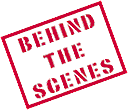THE EARLY YEARS
When I first started RCS Panels, it was with
one word in mind "INNOVATION". I wanted to push the barriers of what could be
done and what could be expected of Flight Simulation on the PC. By that time Microsoft had
done a very good job in providing a solid base simulator. In my mind it just
lacked good panels and aircraft to give it extra realism. Having learnt FS development
from scratch, I had no preconceptions as to what was possible and what was not. It was at
this early stage that the die was cast and the tradition of ground-breaking work was laid.
The first innovation was in the first package - you could change to the FO or Captains set
on the "fly" - the forerunner of the system used on the R4D and others.
After publishing a few packages, and doing development work for a number of
other developers on Voodoo/3DFX compatibility, I produced the series of Airbus panels for
FS98. With co-operation from my friend Tony D'Ambrosio and his RealCRT gauges,
we really moved the realism and quality on quite a long way.
A testament to this early work is that both the panels and the RealCRT gauges are still
favourites with many people today and that they are still being used, two versions of FS
later, with very little change.
I soon realised that the future of developing better, more detailed and accurate panels
was to push the |
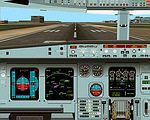 |
| The
RCS-FS98 A340 Panel |
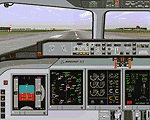 |
| The
RCS-FS98 B717Panel |
| barriers with gauge development, and I spent
considerable time learning those programming skills. |
|
MOVING ON
By the time FS2000 hit the streets, third party add-on's had really moved on a
long way. No longer was it possible to produce a quality product in a few hours. Hundreds
and even thousands of hours were now required to produce a state of the art package.
FREEWARE led the way for quality, mainly because commercial companies did not find
it economically viable to invest the huge amounts of time for the financial return they
would get. It also meant that the days of one person alone developing a complete package
had gone for good. RCS Panels, like others, started to take on other
developers to build a multi-skilled team. Alan Landsburgh came on board
as our sound engineer and we also invited Bill Rambow to join us, as at the time we had
already done a substantial amount of work with him. |
| |
|
| Our major project was to produce an all new, developed from scratch,
R4D that would massively improve on the modified and hacked gauge version that had
been done previously. It would be far more accurate and realistic, with
each part built specifically for the job. As Bill was close at hand to the source R4D at
MAAM, I decided he should act as the Team Leader for that project and produce the graphics
under my supervision. Under the umbrella of RCS Panels, he did that job extremely well as
well as producing the detailed manual, leaving me to concentrate on more complex strategy
and programming tasks. |
 |
| |
The R4D 6 |
MAJOR TURNING POINT
The major turning point in our development came when I became impatient for MS to
release the FS2000 SDK, which would have been required under normal circumstances in order
for me to be able to start work on what was then version 4 of the R4D. In my eagerness to
get the development underway I decided to do some serious investigation into FS2000 to see
what might be possible before we had the luxury of the SDK. This work became an important
corner stone. Using the information and knowledge I gained, many new |
 |
| developments and innovations then followed one after the other. |
The R4D 6
ver 4 |
I developed the first proper night lighting system for gauges. This
groundbreaking approach to lighting has subsequently been much copied and, I have heard,
also led to the current system built into MS FS2002. The MS lighting effects are achieved
in a different way, however, if what I have been told is true, the basic idea started here
at RCS Panels.FLIGHT
SIMULATOR 2000
An important concern at the time with FS2000 was the poor frame rates with
anything that resembled a complex panel. However, with some very efficient programming in
the gauges, their impact could be kept to a minimum even when there were massive amounts
of them. So much so that the R4D v4 returned better frame rates than the default Cessna!!
Due to this success I was able to backwardly develop versions of the R4D version 4 for
FS98 and CFS1. |
| |
Just to give you a feel for the amount of hours involved in a new
package, in the R4D version 4, there were over 7,000 development hours, divided between
four people. This had become a serious business!
You do not need me to tell you that version 4 and 4.75 of the R4D became the yard stick by
which all other packages were measured. This is a tremendous credit to the team and
something of which we are justly proud. Don't think for a moment that either I or anyone
else in the team think that they are better than any other developers, as we don't.
Besides, that is something for you the users to judge - not us. |
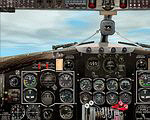 |
| |
The FS2000
R4D Pilots Panel |
DONATIONWARE
During the time we were developing the R4D version 4, it became apparent that MAAM was
struggling for cash, so it was suggested that we should do something to help. The term
"Donationware" was born, and another innovation from RCS Panels that has now
been adopted by many others. We decided to ask people to donate to MAAM if they used and
enjoyed the software. Although this was a very well intentioned idea, it failed, as only one
in every three hundred users ever bothered to send any money !.
|
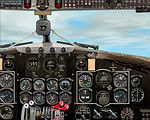 |
| This was extremely disappointing to say the least !! |
The FS2000
R4D FO Panel |
Never one to be beaten, and with innovation as my watch word, I came up with some software
that ensured people had to pay if they wanted to use the product for more than a quick
test. This was incorporated into the FS2002 version of the R4D and was more than 95%
responsible for raising the staggering amount of over $94,000 US for the MAAM Engine
Appeal. This is something of which my team and I are justly proud. This is another example
of an idea that originated with RCS Panels and has since been copied by many others, all
for the real benefit of aviation charities, a noble and worthy cause which we greatly
approve of.
Human nature being what it is, people do not always find it easy to work together and it
became necessary for Bill to "move on" and for the team to distance itself from
MAAM to be able to continue our work in the same honest and innovative ways.
RCS PANELS TODAY
So much for the past, what of the present ? Well, mainly
unseen by the outside world as yet, instead of RCS Panels being primarily myself with a
supporting cast, we are now much more a team of experts in our own specialist
fields. It is because of this that our work continues to push the barriers of what can be
achieved with FS. We believe that FS is all about "important visual
quality" and the "flying experience" and we are now much more concerned
with that than "eye candy".
|
FS2002 brought tremendous potential and FS9 (the next version)
promises even more, according to the information released on the MS website. We now see
one of the weakest links in the chain as the graphics content of any package. Things have
moved on a long way from where a rehashed or modified digital photograph will look good
enough for gauges or cockpit backgrounds.
During last year I was delighted to welcome a new member to the team, in the form of Steve
Wayne. Steve is a man of many exceptional talents, but a real wizard in the digital
graphics field, and new to FS development. As some of you might know, my "day
job" is as one of the world's most renowned Wildlife Artists. I also teach how to
understand and manipulate visual images to create illusions that are not actually there on
a 2D image, but you become convinced they are. Well, add our skills together and you will
start to get a feel of where our current innovation and development is leading.
Already we have raised the bar just in the experimental work we are doing, a little of
which will be seen in our soon to be released FREEWARE B-25, but this is only a precursor
of what is to come in the future.
|
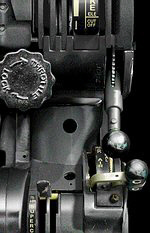 |
Every area is now filled by a professional in his field.
Brian Withers is a recently retired real world RAF pilot who has not only had years of
experience in the cockpit, but also has an in depth knowledge of flight dynamics, aircraft
construction and even FS. The flight models are now done by the numbers, not hit and miss
as before, however good they might have ended up using the trial and error methods so well
known to all of us.The introduction of Gmax was another huge step forward for the FS
community as a whole and a new area of development for us. |
A small
"section" of one of the many new digitally drawn gauges being trialled in our
all new B25. Yes, you read correctly, this is NOT a photo. Over 300 hours spent on
the throttle quadrant graphics for our soon to be released B25. |
All of our new models are now constructed using Gmax. Our soon to be released B25 has
painstakingly been put together in Gmax by Brian with the utmost attention paid to
the level of detail vs the frame rate's in FS in order to achieve the best visual model
possible but at the same time returning excellent performance.
The same is true with the sound packages. Alan our sound engineer has gained hugely in
experience and knowledge since he joined us some years ago. He now also has the equipment
to match his expertise. All of our new Sound Packages are put together using the
latest in hardware and software technology. Sample Rates, Stereo
Separation, Sound Stage Imaging and the overall equalisation are but a few of the
many parameters carefully tweaked by Alan in order to realistically and efficiently
reproduce the "experience" of sitting inside the aircraft.
|
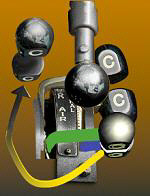 |
| We have also been doing a lot more research and development work, to
enable developers to protect their hundreds of hours of work against "hackers".
For example, the use of such programs as "Gauge Stripper" to suck out code from
gauges and enable "hackers" to reconstitute them as their own work, can now be
identified and proved. Now such people can be brought to book. This obviously also leads
us on to produce better methods of protection. This type of development is also being
extended to other areas, such as graphics, sound, and aircraft ".mdl" files, so
a great deal of important work is going on in those areas. |
Some of the
components of the Quadrant. The 2 Bottom Right "knobs" and levers (green/blue)
are shown in their early stages of drawing. At the end of the arrow are the
completed knobs...(split apart slightly for better viewing) |
In our opinion, far too many talented developers are leaving FS
because their work is not respected.
So what of the future ?? I am sure you will not be surprised to hear that I am not about
to lay out all the detail of what we have coming, but suffice it to say that the
innovations we have come up with during the past five years will probably pale into
insignificance with what is to come. But again I stress that it is up to
you, the users, to be the judge
The current main team (that is; Myself, Steve, Alan, and Brian) is more qualified than at
any time in the past and far more motivated. What we "get off on" is pushing the
limits of what can be achieved within FS |
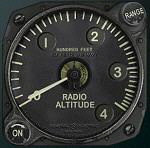 |
| We refuse to be limited by the strict rules and boundries defined in
the FS2002 SDK. The harder it seems, the more interested we are in trying it. |
A sample of
one of our all new new digitally DRAWN gauges found in the B25 |
All our new and original ideas will, for the foreseeable future, be based either around
our B25, or around the Battle of Britain Memorial Flight aircraft, (one C47, one Avro
Lancaster, five Spitfires, four Hurricanes and two Chipmunks). We already have a number of
innovations that are set aside for the BBMF projects, some of which are being trialled in
the B25.
|
RAISING THE BAR
As I said at the beginning of this article, our declared "one and only" aim is
to innovate, raise the bar and push the limits of what is possible.
I know that other long standing groups have the same aim and together, although working
separately, we will push each other to greater and better things. The end result has got
to be good for the hobby of FS the world over. |
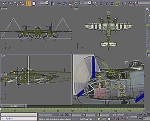 |
| Over the past five years RCS Panels has gained the respect and
support of the vast majority of the |
An early
B25 Gmax Screenshot |
individuals who make up the FS community. Many
are 'real' pilots, many are professional software writers but the largest group are the
huge number of people who enjoy FS just as a hobby. The last five years have also seen
many changes in the FS community. Some for the good and some for the bad. RCS Panels has
always made considerable efforts to keep out of the politics and pettiness and to
concentrate instead on the good things in the community.
We will continue to do so.
|
 |
| I know I speak for our whole team when I say how very much we
appreciate your support. |
Audio
Editing Screenshot |
With it we will continue to 'innovate' into the future |
|

